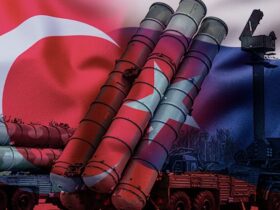Pope Francis made his first foreign trip since the start of the Coronavirus pandemic to Iraq, a country that has been hit with numerous terrorist attacks since Joe Biden took office.
Iraq has been plagued by insecurity and crisis since the US-led invasion in 2003, which took millions of lives among its civilians and forced hundreds of thousands into exile. The Pope’s visit is of great significance and might serve as a pretext for drawing global attention toward the situation in Iraq. His meeting with Ayatollah Sistani, one of the most well-known Shiite religious leaders in the world, has doubled the importance of this trip.
Along with the various news pieces and analyses that have been published about the Pope’s four-day visit to Iraq, the majority of the media’s attention was on the meeting between the two religious leaders, which greatly overshadowed the other details.
Weeks before the Pope’s visit to Iraq and his meeting with Ayatollah Sistani, reactions to this topic began. Different groups offered different assessments of the importance and effects of the meeting.
Different views in Iran on the Pope’s visit
While most of Iraq’s well-known scholars have welcomed this visit and called the Pope’s trip to Najaf ‘a religious leader’s pilgrimage to the birthplace of many religions’, some other groups spoke of possible hidden motives.
In Iran, there were different views among political and domestic bodies on the Pope’s visit to Iraq and his meeting with Ayatollah Sistani, both optimistic and pessimistic.
The optimist view
The optimistic group considers it a significant event in the field of inter-religious relations and believes that the trip could help revive the Interfaith Dialogue that the Islamic Republic has been seeking to establish for decades.
Meetings between Shiite clerics and Christian religious leaders are not new, but the significance of this meeting is that it took place at such a high level that many humanitarian-spiritual missions can take inspiration from it on a global scale.
An example of inter-religious projects proposed by Iranian observers, many of whom believed them to be necessary, was the forming of a stance by religious leaders against any religious, racial or political violence and indiscrimination in the world, particularly when it comes to the issue of Palestine and the organized violence and terrorism against the Palestinians.
Hope for Palestinians?
The Palestinian people are being deprived of their most basic human rights, while the Zionist regime claims to have taken those measures in line with Jewish religious discourse.
In the opinion of this group, another example of an important interfaith joint project is the issue of ethics and defending the sanctity of moral values as a common human value in relationship to global crises. It is also about pursuing peace in conflict and war zones. Some projects related to this include resolving the issues and differences between Christians and Muslims in Africa, resolving the issues that Sheikh Zakzaki faces in in Nigeria due to the influence of Christians in the country, resolving the problems of the Rohingya people in an Interfaith Dialogue between Islam and Buddhism, and standing against the manifestations of Islamophobia in Europe and America.
The statement, that was released after the meeting between the two leaders, also indicated that Ayatollah Sistani had expressed the sensitivities of the Islamic world, especially regarding the issue of Palestine.
The optimists regarding the Pope’s trip to Iraq believe that the visit could increase international sensitivity toward the situation in Iraq and foster international cooperation and assistance to Iraq.
This meeting confirms the spiritual and strategic position of Ayatollah Sistani in Iraq in maintaining peace and tranquility, and in a way, is a show of appreciation for one of the most important religious leaders in the world for his actions towards saving lives in all of Iraq regardless of its religion, language and racial diversity.
The analyses stress the importance of this topic as well as the Iraqi Prime Minister Mustafa Kazemi’s action designating the day of the meeting between two religious leaders a day of tolerance and coexistence in Iraq. “In celebration of the historic meeting in Najaf between Ayatollah Ali Al-Sistani and Pope Francis, and the historic inter-religious meeting in the ancient city of Ur, we declare March 6 a National Day of Tolerance and Co-existence in Iraq,” Kazemi said in a Twitter message.
The sceptical interpretation: hidden motives behind the visit
On the other hand, the pessimistic group believed that the Pope’s visit to Iraq, despite its peaceful and beautiful outward, had hidden motives.
While some believed the Pope’s visit was aimed at strengthening Kazemi’s pro-Western government in Iraq and forging stronger ties between Baghdad and Washington, others saw it as an attempt to expand Western influence in the Middle East, but with a new face in line with Biden’s strategy. The Pope had never referred to the origins of Iraq’s suffering, which was the US invasion, nor did he condemn the US’ behavior in Iraq, leading some to see his slogan of peace as hypocritical.
The propagation of Christianity in the region in an attempt to overshadow Iran and Iran’s Shiite religious leaders against Ayatollah Sistani around the world were among other issues emphasized by those on the pessimistic spectrum.
Referring to the opposition media activities against the Islamic Republic, the group stressed that the Pope’s meeting with Ayatollah Sistani was in fact an attempt to highlight the religious-social discourse of Iraq’s Najaf against the discourse of political Islam dialogue in Iran’s Qom. In their view, the principle of fundamental disagreement between the clerics of Najaf and the leaders of the Islamic Republic on how to act religiously in society and politics is undeniable.
This issue was repeated in the years leading up to the revolution and in the years that followed, when the Ba’athist dictatorship and the severe weakening of the Hawza (Seminary) of Najaf led to the marginalization of these differences, which with the fall of Saddam and the re-emergence of Najaf authority, once again had a bearing. In recent years, this difference has become more prominent and the enemies of religion, Islam and Shiism are emphasizing it more than ever.
For some, it is not out of love for Ayatollah Sistani, but because they want to undermine political Islam, highlighting the actions by the Najaf religious leaders and introducing it as the original Shiite platform.
Despite these differences, the general opinion about the meeting in Iran is positive.

















Leave a Reply